
Radiation Eaters
Not so long ago, everyone believed that the primary source of energy for all life was sunlight—even for carnivores. After all, they eat herbivores that eat vegetation produced by photosynthesis. Ditto for bacteria stuck in the perpetual dark of the human gut, or for lightless ocean-bottom ecosystems that utilize oxygen dissolved in seawater—oxygen created by sunshine in plants and algae above. Ultimately, it seemed, everything depended on the Sun.
But in the 1970s, scientists began discovering exotic organisms that play by astonishingly different rules. Now, a team searching deep in a South African gold mine has found one that redefines the limits of life: Bacteria that subsist in rock at huge pressure for thousands of years by "eating" by-products of radioactivity, completely isolated from organic matter or results of photosynthesis.
Researchers Lisa Pratt and Tullis Onstott think the microbes may have first trickled down there between three and 25 million years ago, and were forced to survive on the leftovers that result when radioactivity from uranium in the native rock breaks down molecules of water and pyrite (iron sulfide, or fool's gold). They developed a metabolism based on hydrogen ions and sulfur compounds, rather than the more familiar, carbon-centered organic chemistry used by their topside cousins.
These rock-dwellers may be some of above-ground life's oldest relatives. Pratt and Onstott suspect that they're probably not much different now than when they were separated from the surface, because they grow very slowly to conserve scarce nutrients. Extremely slowly: Whereas E. coli, found in the intestines of mammals, divide every few minutes, the subsurface microbes reproduce once a year at most, and possibly only every 300 years... or more! So far, researchers haven't been able to grow them in the lab. But they are working on genomic sequencing to evaluate how closely related the newly discovered bacteria are to other extremophiles, as well as surface organisms.
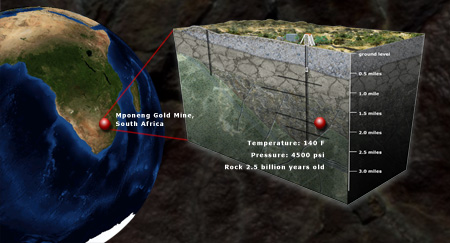
Location
Mponeng Mine, South Africa
Temperature: 140 F
Pressure: 4500 psi
Rock 2.5 billion years old
Scale: Ground level, 0.5 miles, 1.0 miles, 1.5 miles, 2.0 miles, 2.5 miles, 3.0 miles
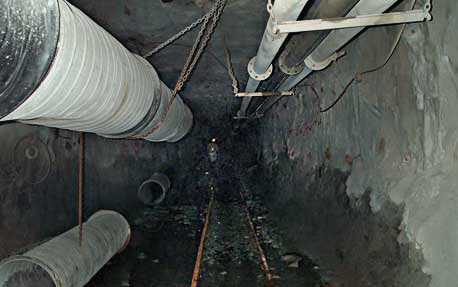
This tunnel leads to the section of the Mponeng gold mine in South Africa where the "radiation-eating" microbes were found in water flowing from a fracture in the rock.
Credit: Duane P. Moser, Desert Research Institute
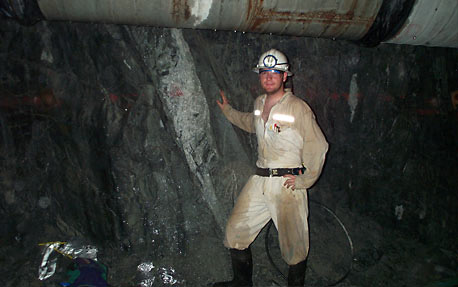
Student researcher Brett Tipple of Indiana University stands in front of the Mponeng fracture two months before mine crews tunneled through it.
Credit: Duane P. Moser, Desert Research Institute
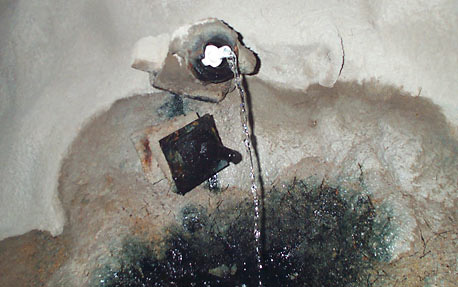
This bore hole at the Mponeng fracture site was still releasing ancient underground water two months after it was first intersected by the tunneling, although its rate of flow had greatly diminished.
Credit: Duane P. Moser, Desert Research Institute
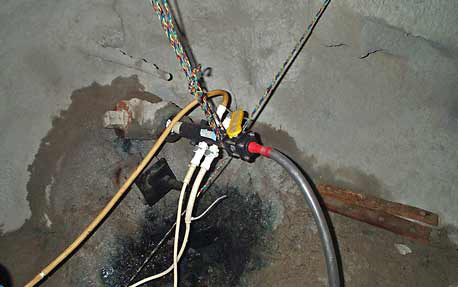
The bore hole was fitted with a sterilized sampling manifold to collect water, gas and microbial samples
Credit: Duane P. Moser, Desert Research Institute
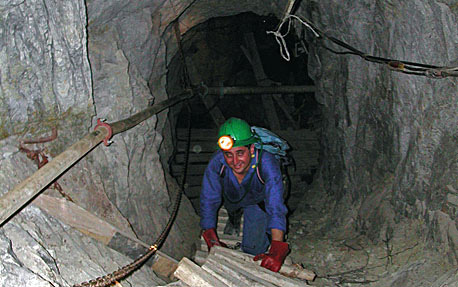
Researcher Erik Boice, part of a multi-institutional team searching for exotic microbes in South Africa, ascends on a wooden ladder from Kloof #4 Gold Mine near Carletonville.
Credit: Courtesy of Lisa M. Pratt, The Trustees of Indiana University, NASA, NSF
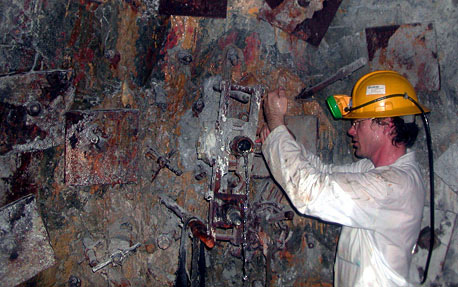
Tullis Onstott of Princeton University, co-leader of the group of researchers from nine collaborating institutions, opens a bore hole in a section of rock wall near the area where the "radiation-eating" microbes were found.
Credit: Courtesy of Lisa M. Pratt, The Trustees of Indiana University, NASA, NSF
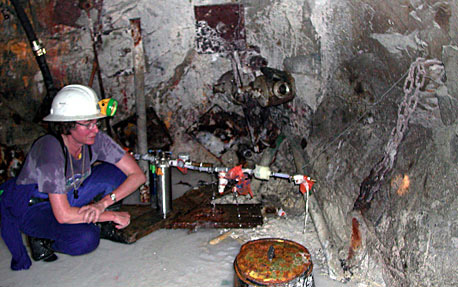
Lisa Pratt of Indiana University, co-leader of the multi-institutional team, monitors water flow through filters deep in the Kloof #4 Gold Mine.
Credit: Courtesy of Lisa M. Pratt, The Trustees of Indiana University, NASA, NSF
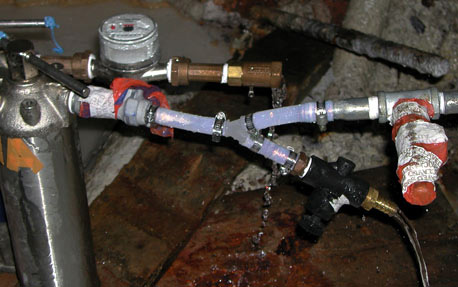
Researchers use different kinds of filters fitted onto collection equipment to trap different types of biological specimens. The cartridges, valves and connecting lines shown here were sterilized in an autoclave prior to deployment in Kloof #4 Gold Mine. The team took water samples for nearly two months at the site.
Credit: Courtesy of Lisa M. Pratt, The Trustees of Indiana University, NASA, NSF
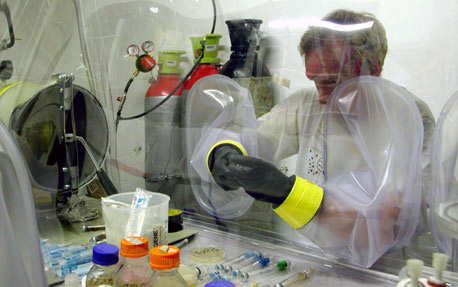
Once samples are removed for analysis, they must be shielded from contact with oxygen in the air. Here researcher James Hall, working in a temporary microbiology lab set up near the mines, places water from deep in the rock into a microbial growth medium.
Credit: Courtesy of Lisa M. Pratt, The Trustees of Indiana University, NASA, NSF
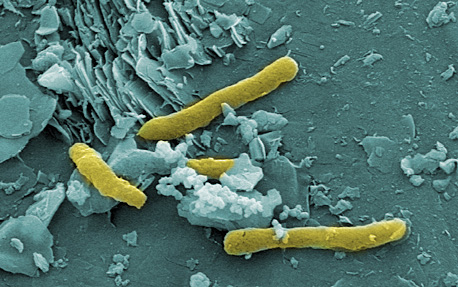
This color-enhanced scanning electron microscope image shows unidentified microbes found in water from a different fracture zone than the one containing "radioactivity eating" organisms. This fracture was about a mile from any current or historical mining activity, and thus minimally affected by human intrusion.
Credit: G. Wanger and G. Southam, University of Western Ontario
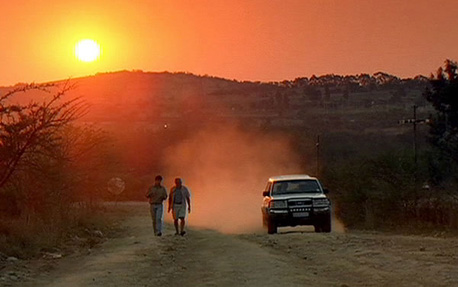
Dusty roads lead to one of the microbe research sites in the deep gold mines of South Africa.
Credit: From "The Sacred Balance." Used by permission from Kensington Communications, Inc., www.sacredbalance.com
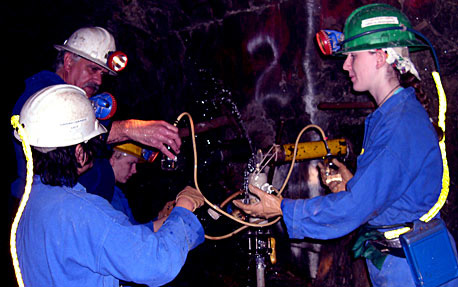
At a mine in South Africa, students from the University of Tennessee collect water samples and scrape biofilm off the rock wall under the supervision of professor Derek Litthauer (far left). The 2003 field work was part of a Research Experiences for Undergraduates (REU) program.
Credit: Susan Pfiffner, University of Tennessee
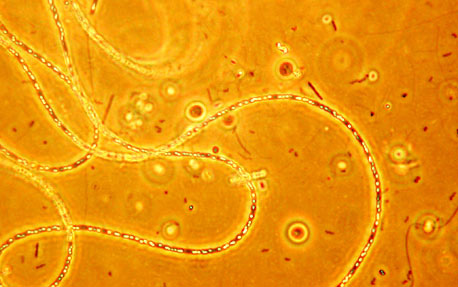
This microscope image shows metal-oxidizing bacteria found in biofilm samples taken from a South African gold mine by University of Tennessee students.
Credit: Courtesy of University of Tennessee, Knoxville and University of the Free State, South Africa's Research Experiences for Undergraduates program
Any opinions, findings, conclusions or recommendations presented in this material are only those of the presenter grantee/researcher, author, or agency employee; and do not necessarily reflect the views of the National Science Foundation.



